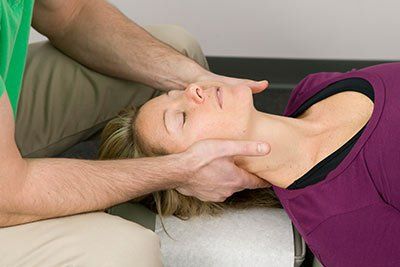BLOG

Chronic pain affects millions of people worldwide. It can be debilitating and interfere with your daily activities and quality of life. Physical therapy is an effective approach for managing chronic pain, helping patients alleviate their symptoms, and improve their overall physical function and mobility.

According to the Centers for Disease Control and Prevention, lower back pain “is the second most common cause of disability in US adults.” The scientific journal Neurologic Clinics estimates that “15% to 20% of adults have back pain during a single year and 50% to 80% experience at least one episode of back pain during a lifetime.” They also note that low back pain affects everyone “from adolescents to the elderly, and is a major cause of disability in the adult working population.” With something so common, it’s easy to underestimate the risks. But this can be fatal if you’re a woman over the age of 65. A study published in the Journal of General Internal Medicine reports that “back pain increases the risk for death among older women by 24 percent.” What’s also troubling is that the researchers aren’t sure why. They merely theorize that the pain may prevent exercise and cause weight gain, which can lead to a host of “chronic health conditions, and ultimately earlier death.” Fortunately, there are many ways to reduce, if not prevent, most kinds of back pain. According to the Mayo Clinic, “if prevention fails, simple home treatment and proper body mechanics often will heal your back within a few weeks and keep it functional.” Whether your back pain requires professional intervention or can be successfully treated at home, seeking an evaluation is essential and will not only result in a quicker recovery, but potentially a longer life if you’re a woman over 65. So, when should you call a doctor? The Mayo Clinic urges anyone experiencing back pain to contact a physician if the pain lasts more than a few weeks, doesn't get better after resting, spreads to your legs, results in weight loss, or “causes weakness, numbness or tingling in one or both legs.” But what kind of expert should you reach out to? U.S. News recently covered the dizzying options available to those in pain. “Depending on the cause of your back pain, you might end up seeing any one of a variety of specialists.” Their list included "primary care physicians, physiatrists, pain management specialists, sports medicine doctors and spine surgeons.” It seems the best option is to find a clinic that offers a variety of treatments and takes a multidisciplinary approach to your pain. At Coastal Pain & Neurology Centers, that’s precisely what we do. With a range of minimally invasive treatments and technologies, our experts will diagnose and manage your pain to help you not only regain your quality of life, but make sure you don’t face the increased mortality rates that back pain causes in women over the age of 65. So if you’re in pain, don’t wait. Schedule an expert assessment now.

Every year, millions of workers are injured on the job. According to the National Safety Council, workplace injuries occur every seven seconds, resulting in “99 million days of lost productivity on an annual basis.” The most common injuries are: SLIP & FALLS Slip and falls are the most commonly reported workplace accidents and a leading cause of injuries. (It’s important to note that a fall does not have to occur from a great height to cause great harm.) STRUCK-BY INJURIES Struck-by injuries are those in which a worker is struck and injured by a moving object. Any object that rolls, slides, swings, falls, etc., can cause this type of injury. Construction workers and factory employees are among the most vulnerable to struck-by injuries, but they can happen anywhere and in any workplace. HIGHWAY WORK ZONE ACCIDENTS A variety of injuries can occur in these hazardous zones, and Florida ranks among the states with the most fatalities at road construction sites. REPETITIVE MOTION INJURIES Repetitive motion injuries (aka repetitive stress injuries) are caused by repeating the same motion over and over. Carpal tunnel syndrome is a common repetitive motion injury. Such injuries can be temporary or permanent, and affect your muscles, nerves, ligaments, and tendons. Typists and retail workers often suffer from repetitive motion injuries. OVEREXERTION Every year, there are more than 3 million hospital visits because of overexertion. Lifting heavy objects with your back, rather than your legs, is one way to overexert yourself, resulting in sprains and strains that can cause pain. If you’ve had the misfortune to suffer one of these injuries, or another, on the job, it’s important to know that Florida’s workers' comp will cover all medical expenses resulting from the injury. At Coastal Pain & Neurology Centers, we’ve spent over twenty years helping members of the community get back to work and regain their quality of life. So, whether you choose to visit us, or another reputable clinic, don’t wait to seek treatment.

If you have frequent neck pain, there are three common sources that might be responsible for yours. 1. Poor Ergonomics at Work If you find yourself slouching or looking at your computer from an awkward angle, you might be placing strain on your neck and trapezius muscles. Awkward and repetitive movements such as these might be responsible for your discomfort. But there's something you can do about it. If you sit at a desk for hours at a time, make sure your computer is at eye level. Otherwise, staring upward for an extended period may cause pain. Do you do a lot of lifting on the job? If so, practice proper lifting techniques to avoid injury. Lifting a load too far from your body while looking downward can lead to strain. Also, remember to keep your chin up, your feet shoulder-width apart, and your load close to your body. If you work in a warehouse or on a construction site, avoid repetitive and awkward motions to your head and neck whenever possible. Also, try to take 15-minute breaks periodically. 2. Using an Old and/or Misshapen Pillow Does your pain begin when you first wake in the morning, then gradually diminish throughout the day? Your pillow might just be the culprit. Flattened pillows more than 2 years old don't provide adequate support. They can even throw your spine out of alignment or cause you to sleep in an awkward position, resulting in pain. Avoid sleeping on two pillows or with a pillow that's too firm. And you should trade your flattened pillow for one that offers adequate support--one that's designed for your usual sleeping position. If you sleep on your stomach, try to break this habit, as it places undue strain on the neck. You can always ask your physician or physical therapist for pillow recommendations. Orthopedic pillows are made to alleviate neck and back problems. Many are also contoured to accommodate the curves of your neck. Perhaps a memory foam or latex foam pillow will be best for you! 3. Failure to Warm Up Prior to Exercise If you exercise regularly or participate in sports, it's important to warm up beforehand. Simply performing sit-ups or pushups without properly stretching can result in pain. Stretching your neck in a gentle manner increases flexibility and reduces the risk of injury. Also , remember to rest between sets or workouts. Despite your best efforts to be conscientious while working, sleeping, and exercising, you might still experience pain. If so, and if you're unable to find relief, seek an evaluation from an experienced medical professional. For more information, call us at (386) 788-2300.

The Arthritis Foundation reports that osteoarthritis often leads to the loss of a synovial fluid known as hyaluronic acid. This fluid is what keeps the joints lubricated, so a loss of it can leave you feeling stiff and lead to pain over time. Hyalgan knee injections are specifically designed to replace lost fluid and restore comfort. If you're considering Hyalgan knee injections, review these frequently asked questions to gain a better understanding of the procedure and how it works. 1. Who Is a Good Candidate for Hyalgan Knee Injections? Patients who have tried conventional treatments for osteoarthritis but haven't found relief are excellent candidates for Hyalgan knee injections. But physical therapy, heat or cold treatments, specialized exercises, and over-the-counter pain medications should all be exhausted before considering Hyalgan knee injections. 2. Are There Any Side Effects? It is important to consult your physician and review the ingredients found in Hyalgan to see if there is any risk of an allergic response. Typically, the injection contains processed poultry combs, which could produce a negative reaction in individuals allergic to eggs, chicken, or feathers. Your physician should also examine your knee and surrounding area to make sure there is no evidence of infection. Finally, they should disclose any other possible side effects, like pain near the injection site, redness, or swelling. 3. How Many Treatments Will I Need? The number of treatments varies for each patient and is contingent upon how severe the osteoarthritis is. Treatments are administered on a weekly basis and you may find relief after just one Hyalgan knee injection while some require as many as 12. Your physician will then closely monitor you each week and review your pain level, stiffness, and whether your mobility is increasing or the same. Once the gel begins to take effect, relief is expected to last several months. 4. Will I Need to Repeat Treatments Again in the Future? Currently, there is no known cure for osteoarthritis. Although the Hyalgan knee injections will provide relief for a significant amount of time, they won't keep the pain away for good. Patients will need to repeat treatment as needed, which could be as little as two to three times per year (depending on how your body reacts). 5. Do I Have to Stop Taking Any Medications to Receive Hyalgan Knee Injections? If you have any other medical conditions that require taking medication on a regular basis, you'll be happy to learn that there are no drug interactions with Hyalgan knee injections, as Hyalgan is derived from natural products and doesn't enter your blood stream. And it is injected around the knee, so only your knee is affected. 6. Can I Use the Hyalgan Knee Injections in Conjunction With Other Osteoarthritis Treatments? In many cases, implementing more than one therapy is very beneficial. Your doctor may suggest incorporating a few key exercises into your daily routine. The exercises will be designed to increase muscle strength, extend your range of motion, and fortify your bones and ligaments. A good workout will also help for weight loss, which is beneficial to one's knees. More questions? Contact Coastal Pain & Neurology Centers. We are eager to create a care plan to alleviate your pain and restore the function of your knee so you can get back to doing the things you love!

Whiplash is a painful condition that can have long-lasting effects. Around a million people are affected by whiplash each year. Most often, this injury occurs after a car accident. Continue reading to learn what you can do to alleviate your pain. What Is Whiplash? Whiplash is a common and debilitating neck injury caused by a sudden forward motion of the neck followed by a quick snap backward. Commonly caused by a car accident, whiplash can also result from sports, falling down, or other strong forces. Whiplash affects your neck muscles and tendons by straining and tearing them, resulting in pain. Whiplash may be present for several days or weeks before the pain becomes noticeable; although, many people show signs immediately. Recognizing the signs of whiplash is important and will help you to seek medical attention right away. Below are red flags commonly associated with whiplash. 1. If You've Recently Had an Injury Your neck pain may be associated with a recent injury. If you've hit your head, or if it has flung forward and backward with sufficient speed and force, or if you've suffered a concussion, you may have whiplash. Even if your injury was many weeks ago, it's important to consult a specialist in order to be treated properly. 2. If You Have Recurring or Lingering Headaches Headaches that begin at the base of your neck and radiate outward can be a sign of whiplash, especially if you've had a recent injury or been in a car accident. Make a note of when and where your headaches occur and how severe they are, then share this information with your doctor or chiropractor so they can determine if there has been any nerve damage. 3. If Your Neck Feels Stiff A stiff and painful neck can be a sign of whiplash. You may feel pain when moving your head from side to side or when rotating it back and forth. Since whiplash injuries can take a long time to heal without proper treatment, don't ignore this kind of pain. 4. Your Neck Pain Won't Go Away If your neck pain persists or increases, despite your best efforts, you might have whiplash. Whiplash is hard to treat at home and requires professional care, which means that heat, ice, and over-the-counter medications may not work––or only work temporarily. With professional care, however, your whiplash can be effectively treated. At Coastal Pain & Neurology Centers, our team of experts will diagnose and treat your injury to alleviate your pain.

While most headaches cause significant discomfort, the pain associated with a migraine has the ability to completely disrupt your life. Treating migraine headaches can be challenging, especially since many of the treatments available today are designed to address the symptoms and not the source. If you're suffering from frequent migraines, and they're affecting your daily routine, an experienced chiropractor might help. Chiropractic care has the ability to treat the root cause of your migraines, thereby reducing migraine episodes. Here are three unique ways that chiropractic care can treat migraines and help you find relief. 1. Restoration of Nerve Communication Your body is regulated, in part, by a system of nerves that send signals from different parts of your body to your brain. These signals tell your brain what types of sensations you should be feeling. When the pathways used by nerve signals become blocked, you can experience a variety of side effects. It's not uncommon for nerves to become blocked as a result of alignment problems within the spinal column, and migraines can be exacerbated by the presence of these blockages. An experienced chiropractor has the ability to manipulate your spinal column to restore proper alignment. This helps to restore efficient nerve communication and reduce the number of migraines you experience on a daily basis. 2. Alleviation of Muscle Tension Many things can trigger the onset of a migraine headache, and muscle tension is a common trigger. There's a relationship between the alignment of your spinal column and the amount of muscle tension you experience in your back, shoulders and neck. When a spinal vertebrae is out of alignment, this subluxation places stress on the surrounding muscle tissue. The muscles tense up in an effort to pull the vertebrae back into alignment, leading to increased soreness and inflammation. By seeking regular chiropractic care to keep your spine properly aligned, you can reduce the amount of tension in your back, shoulders, and neck. This reduction in muscle tension can help prevent the onset of migraines, allowing you to find relief over time. 3. Improvement of Circulation Proper circulation is critical when it comes to the overall health and performance of your body. If you suffer from migraine headaches, changes in the blood flow to and from the blood vessels within the brain can contribute to the pain you feel when a migraine sets in. Regular chiropractic care to keep your musculoskeletal system in alignment will help prevent blood flow issues, preventing them from contributing to migraine pain in the future. To learn more about how you can create a customized care plan that allows you to better control the onset of your migraines through chiropractic care, contact the professionals at Coastal Pain & Neurology Centers.

Vertigo sufferers experience a feeling that everything around them is moving or spinning. This feeling is often accompanied by vomiting, difficulty walking, and/or sweating. Causes of Vertigo Peripheral vertigo is most commonly associated with an inner-ear condition, such as fluid and crystal build-up in the inner ear, hearing loss, or tinnitus. This condition can arise from a head injury, stroke, or infection. Central vertigo, on the other hand, stems from issues of the spinal cord or brain. If your symptoms resemble those of vertigo, it's important to consult a neurologist and identify the cause to develop an appropriate treatment plan. Treatment Methods for Vertigo Treatment may include avoiding stress-filled environments, practicing controlled movements of the head, anti-inflammatories, neurological treatment, prescription medication, and surgery. If you're suffering from vertigo, consult a medical professional as soon as possible. At Coastal Pain & Neurology Centers, we can effectively diagnose and treat for your condition, so call us today: (386) 788-2300.

A hard day’s work can result in strain or injury, but many are unaware of the impact caused by repeated movements. Activities ranging from typing and clicking to assembly line work can require sustained, repetitive movements. If you're experiencing aches and pains that are not associated with an inflammatory condition such as arthritis, you could have a repetitive stress injury. Causes and Risks Unlike most injuries that occur from a single incident, repetitive stress injuries are caused by doing the same movement for an extended period of time. This can cause strain to muscles, joints, and tendons over time, causing irritation and injury. Risk factors include work-environments that involve typing, assembly line work, or similar repetitive tasks. Symptoms Because this injury develops from completing the same activity over and over, symptoms can appear gradually and worsen over time. If you have a repetitive stress injury, you’ll likely experience throbbing, tension, and pain in the joints or muscles you are using. You can also experience numbness or tingling in the affected area. These symptoms may temporarily improve if you stop the motion. If you work in a field that requires repeated movements and you experience ongoing pain, you might have a repetitive stress injury. For more information, contact the experts at Coastal Pain & Neurology Centers.





